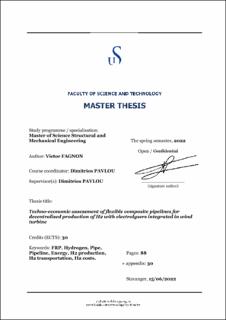| dc.description.abstract | Hydrogen gas, H2, is currently creating a lot of attention from governments
and companies. The potential applications bring a lot of attention and, even too
much when regarding in details the situation. Liquid hydrogen appears irrelevant
to satisfy a global hydrogen network due to the extreme conditions required and
its huge energy loss to obtain this phase.
Since hydrogen is not an energy, it must receive power to be produced and
this is currently driven by fossil energies at 95%. Electrolysis of water has been
analysed and is found to be an interesting way of H2 production with an acceptable
efficiency, no CO2 emissions and a decent adaptability to intermittent renewable
sources of energy such as wind. However, it still keeps a high cost with a ratio
from 2 to 3 times the price from using fossil fuels instead.
About the pipeline transportation, GFRP and GRE seem to be the most sus-
tainable FRP pipes regarding the energy and carbon footprint. From an actual
hydrogen pipe and other similar pipe products, the features are usually composed
of a diameter up to 6" (152mm), a temperature and pressure resistance around
80°C and [40 ; 80] bar with a lifetime between 20 to 50 years and made of either
glass or aramid fibres for the reinforcement.
Regarding the economy, on one hand, hydrogen produced from electrolysis has
costs in the range [2.5 ; 5.5]€/kg. The compression stage costs [0.9 ; 1.75]€/kg
where the actual compressor price is between 45 000€ to 90 000€. In comparison,
fossil fuel energies produce hydrogen at a cost of [1.5 ; 2]€/kg which fade the
cost competitiveness away.
On the other hand, the hydrogen transportation costs are found in the or-
der of [0.139 ; 0.261]€/kg for a minimum demand of 5 million of tonnes per
year. In a recent report, costs for offshore pipeline are estimated to reach [0.17 ;
0.32]€/(kg·1000km). In addition, the price of FRP pipeline is globally comprised
between 32$/m and 46$/m and could reach a maximum of 66$/m for difficult
installation conditions.
For strategic purpose, it is important to remind that hydrogen is an energy
carrier and requires a huge amount of energy to be produced, process mainly done
by fossil fuel today. An interesting way for decarbonising the society would first to
replace this major production by a renewable production of hydrogen which would
need a transportation assured by pipelines for reducing environmental footprint,
costs, times and increasing quantity with efficiency. | |
